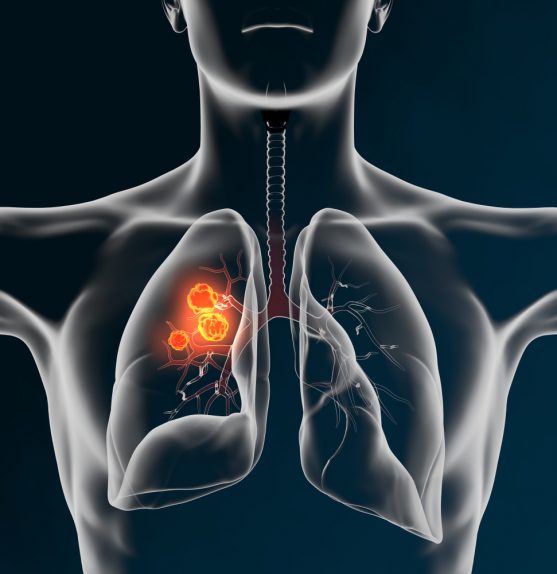The author of this article is Dr Tanmoy Kumar Mondal, Sr Medical Oncologist, trained from Tata Memorial Hospital. He is currently practising at Netaji Subash Chandra Bose Hospital, Kolkata.
As with all cancers, detecting lung cancer early can improve its the outcomes of treatment. However, it is mostly detected in the advanced stages, as there may not be any symptoms in the early stage.
Therefore, it is important that people who have a high risk for developing lung cancer are screened regularly.
Lung cancer is one of the most common cancers and led to 2.09 million cases and 1.76 million deaths in the year 2018, globally. It is the most common cancer in men and the third most common cancer in women.
In India, lung cancer accounted for 67,795 new cases and 63,475 deaths in the year 2018.


Based on the appearance of cells under the microscope, lung cancers can be categorized into small cell lung cancer (SCLC) and non-small cell lung cancer (NSCLC).
SCLC is an aggressive cancer mostly found in heavy smokers. It accounts for 10-15% of all lung cancers.
NSCLC is more common compared to SCLC, and accounts for about 80-85% of all lung cancers.
According to studies, people who smoke cigarettes have a 15 to 30 times greater risk of developing lung cancer and dying from it than non-smokers.
Additionally, second-hand smoke, occupational exposure to asbestos, air pollution, and a family history of lung cancer also increases the risk of lung cancer.
Although lung cancer cannot be prevented, its risk can be reduced by taking necessary precautions, and screening is one among them.
Screening for lung cancer helps in early detection of cancer and prompt initiation of treatment that can reduce mortality.
Screening for lung cancer is done with a test called a low-dose computed tomography scan (LDCT). LDCT is a noncontrast study (which means IV contrast is not used) obtained with a multidetector CT scanner with a scanning time under 25 seconds.
Low-dose Computed Tomography (LDCT)
Radiation dose exposure is less than a third of a standard-dose diagnostic chest CT scan.
Clinical trials showed that screening with LDCT scan has reduced the risk of dying from lung cancer in people at high risk of lung cancer.
Lung cancer screening is not for everyone, it is recommended only in those who have a high risk for developing lung cancer.
According to the American Cancer Society (ACS), lung cancer screening must be done every year in individuals aged between 55 to 74 years who are in good health and who:
A lung cancer screening may carry the following risks:
Lung cancer cannot be prevented completely, but taking preventive measures to avoid the risk factors may lower the risk of lung cancer.
Smoking is the most preventable cause of lung cancer
Having a healthy diet rich in fruits and vegetables, and exercising regularly, may help reduce the risk of lung cancer. There are studies which suggest that a diet high in fruits and vegetables may help protect against lung cancer in both people who smoke and those who don’t.
Include plenty of fruits and vegetables in your diet
You can read more about the foods that are good for your lungs here.
కీమోథెరపీ కోసం క్యాన్సర్ రోగులు ఎలాంటి దుస్తులు ధరించాలో తెలుసా? ఈ ఆర్టికల్లో, క్యాన్సర్ రోగులకు కీమోథెరపీని సౌకర్యవంతంగా పొందడంలో సహాయపడే దుస్తుల జాబితాను అందించాము.
ఈ కథనం మీ క్యాన్సర్ రకానికి సరైన క్యాన్సర్ వైద్యుడిని కనుగొనడానికి 6-దశల గైడ్ను వివరిస్తుంది.
तंबाकू का सेवन गुटका, जर्दा, पैन मसाला आदि के रूप में करना सिर और गले के कैंसर का मुख्य कारण…
నోటి పుండ్లతో బాధపడుతున్న క్యాన్సర్ రోగులకు క్యాన్సర్ చికిత్సలో ఉన్నప్పుడు తీసుకోవాల్సిన 12 ఉత్తమ ఆహారాలు.
క్యాన్సర్కు కారణమయ్యే 6 జీవనశైలి కారకాలు గురించి ఈ కథనంలో వివరంగా ఇవ్వబడ్డాయి. అవి ఏమిటో తెలుసుకోండి!
शोध की मानें तो न्यूज़पेपर प्रिंट करने में जो स्याही का इस्तेमाल होता है उसमें ऐसे केमिकल होते हैं जो…